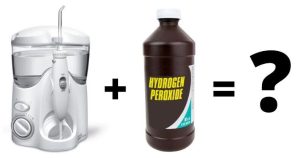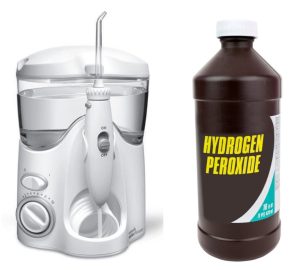Are you wondering if you can put hydrogen peroxide in your Waterpik? And if so, how much?
A Waterpik water flosser with hydrogen peroxide can be an excellent tool to enhance your dental health when used the right way.
In this article, we’ll explore:
- What is hydrogen peroxide?
- How to use hydrogen peroxide in your Waterpik
- How not to use hydrogen peroxide in your Waterpik
- How to clean a Waterpik
Our goal with this article is to answer all the questions you may have about using hydrogen peroxide in Waterpik water flossers.
- Is it safe? Yes it is safe, as long as you use a low, diluted, concentration of a maximum of 3%. You should fill half of the tank with this solution, and half the tank with normal water.
- What concentration to use: Use a maximum concentration of 3% and fill half of your water flosser tank with this solution, and the other half with normal water.
- Benefits: Using hydrogen peroxide in your water flosser can improve your gum health and help treat canker sores.
- Frequency: Ask your dentist – but generally at least once per week is reccomended, and there is no indication that doing this everyday is harmful to your gums.
- Upgrade your water flosser: If it’s time to replace your WaterPik, consider our top pick for water flossers – the cariPRO cordless. It’s an affordable option with 4 specialty tips and a 60-day trail period. Try it out!
In This Article
- 1 Can I put hydrogen peroxide in my Waterpik?
- 2 How much hydrogen peroxide should I put in my Waterpik?
- 3 What are the benefits of using hydrogen peroxide in a Waterpik?
- 4 Are there risks of using hydrogen peroxide in a Waterpik?
- 5 How to Clean a Waterpik
- 6 Keep the following in mind when using hydrogen peroxide in a Waterpik
- 7 Conclusion
Can I put hydrogen peroxide in my Waterpik?

The answer is yes. Hydrogen peroxide rinses with low concentrations are completely safe, and you can put hydrogen peroxide in your Waterpik water flosser.
How much hydrogen peroxide should I put in my Waterpik?
You are probably wondering how much hydrogen peroxide in your Waterpik is safe to use. To remove debris and hazardous germs from your teeth and gums, use a diluted 3 percent hydrogen peroxide solution.
To begin water flossing with hydrogen peroxide, hold the Waterpik upright, and open the reservoir lid. Half-fill the tank with lukewarm water. Then fill up the second half with a 3 percent hydrogen peroxide solution.
Close the tank lid and make sure it’s locked. To use the Waterpik, turn it on and direct the nozzle towards your teeth. Rinse the gums between your teeth for around five seconds each tooth with a 1:1 solution of 3 percent hydrogen peroxide and water.
What are the benefits of using hydrogen peroxide in a Waterpik?
One of the key advantages of using hydrogen peroxide in a Waterpik is that it can reach hard-to-reach areas that normal toothbrushing and flossing can’t get to. Health benefits may include gingivitis prevention and treatment, and teeth whitening.
Some of the other advantages are:
Gingivitis treatment
If you have sensitive gums that bleed and are often inflamed or red, which are indicators of gingivitis, hydrogen peroxide in your Waterpik may be an effective therapy choice. Gingivitis is treated by rinsing the gums with a liquid that destroys the germs that cause the condition on a regular basis. Using hydrogen peroxide in a Waterpik is helpful in this situation.
Helps relieve a sore throat

A sore throat may be treated by using hydrogen peroxide in a Waterpik. One of the causes of sore throat is a fungus infection. Rinsing with hydrogen peroxide may help to alleviate the symptoms while also reducing the irritation produced by the germs.
It can prevent gingivitis
The antibacterial properties of hydrogen peroxide in your Waterpik aid to cure gum disease, improving your oral hygiene. Hydrogen peroxide creates oxygen, which destroys bacteria that create plaque — a sticky covering that forms on the surface of your teeth — when gargled or used in a Waterpik.
Treatment of mouth ulcers
Using hydrogen peroxide in your Waterpik might assist if you have mouth ulcers. Hydrogen peroxide aids in the killing of bacteria, cleaning surfaces, and the removal of dead tissue. And it’s possible that this method may expedite the healing of a mouth ulcer or a minor scrape.
Teeth Whitening
Using hydrogen peroxide in your Waterpik could also help with teeth whitening. Many kinds of toothpaste and mouthwashes that are meant to whiten teeth include it as an ingredient.
Although using hydrogen peroxide to whiten teeth is helpful, there are more effective ways to whiten your teeth such as by using carbamide peroxide. If teeth whitening is the main reason you want to put hydrogen peroxide in a Waterpik, then you might want to check out this article about teeth whitening with hydrogen peroxide.
Take a look at why the cariPRO water flosser is one of the best options for your teeth:
- 4 specialty flossing tips (ortho, implants, gum pockets, and standard)
- 3 flossing modes (normal, soft, and pulse)
- 2-year warranty
- 60-day trial
- High-quality design
- Soft-touch, non-slip handle
- 360-degree rotating tips
In short, the cariPRO water flosser offers everything a toothbrush needs to maximize your oral health. Click here to view full product details and get the best price today!
Are there risks of using hydrogen peroxide in a Waterpik?
Yes, there are potential risks associated with using hydrogen peroxide in a Waterpik. Aside from having a terrible aftertaste, it can also be hazardous when used in the wrong way.
- Harmful when consumed: Too much hydrogen peroxide in the stomach may produce major adverse effects such as stomach burning, nausea, and vomiting.
- Weakened enamel: If used for too long, too frequently, or in too high doses, hydrogen peroxide may harm tooth enamel.
- Temporary oral irritation: It may also cause oral irritation, with symptoms that might continue for many hours.
- Dry mouth: Peroxide may make your mouth dry, which is harmful to your oral health. Saliva is necessary for the removal of bacteria from your mouth as well as the remineralization of tooth enamel.
- Black hairy tongue: This is a fairly innocuous and temporary oral issue that seems to be much worse than it is! It may happen if you use mouthwashes that include oxidizing agents like peroxide.
Hydrogen peroxide should only be used when diluted with water!
How to Clean a Waterpik
It’s important to keep your Waterpik clean to ensure it’s performing effectively!
The following video will outline a step-by-step guide on how to clean a Waterpik water flosser:
Keep the following in mind when using hydrogen peroxide in a Waterpik

Using hydrogen peroxide in Waterpik water flossers has benefits and potential risks. Keep the following in mind:
- Before using hydrogen peroxide as a mouthwash or adding it to your Waterpik, make sure you dilute it appropriately with water.
- Long-term usage of hydrogen peroxide raises the risk of salivary free radical production, which is linked to precancerous tissue alterations.
- You should stop using diluted hydrogen peroxide in your Waterpik if it causes burning or swollen gums.
Be sure to consult a doctor before starting a new oral hygiene routine.
Conclusion
Using hydrogen peroxide in a Waterpik is a more advanced method of cleaning between and around your teeth.
If you’re looking to cure a particular oral condition or just want to enhance your general dental health, hydrogen peroxide may be an excellent option. However, consult your dentist before adopting it into your daily regimen. Also, make sure to consult a doctor for a diagnosis.
It’s worth repeating that a Waterpik with hydrogen peroxide should only be used after being diluted with water.
Depending on what you are trying to achieve, you might also want to use hydrogen peroxide as a mouthwash, aside from using it in a Waterpik or other water flosser. On a related note, we have a guide that answers the question: Can you put mouthwash in a Waterpik?
If your main reason for using hydrogen peroxide in a Waterpik is to whiten your teeth, you may check out other, more effective, alternatives.




